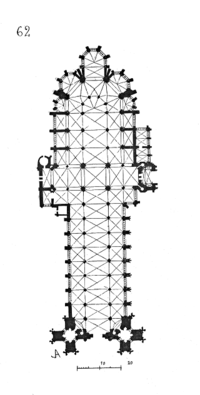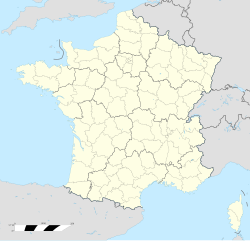
Back Kostel Saint-Ouen de Rouen Czech St-Ouen (Rouen) German Abatopreĝejo Sankta Oveno Esperanto Iglesia abacial de Saint-Ouen Spanish Abbaye Saint-Ouen de Rouen French Église Saint-Ouen (Rouen) Frisian כנסיית סנט אואן HE Chiesa abbaziale di Saint-Ouen Italian Abdijkerk van Saint-Ouen in Rouen Dutch St. Ouen-kirken i Rouen NB
| Saint-Ouen Abbey | |
|---|---|
| Saint Owen Abbey[1][2][3] | |
Abbaye Saint-Ouen de Rouen | |
 The Abbey Church as seen from the Great Clock | |
| 49°26′33″N 1°05′59″E / 49.44250°N 1.09972°E | |
| Location | City Hall Square, Rouen, Normandy |
| Country | France |
| Denomination | Catholic |
| Website | rouen |
| History | |
| Status | Abbey Church |
| Founded | 750[4] |
| Dedication | Saint-Ouen |
| Dedicated | 17 October 1126 |
| Relics held | Saint-Ouen |
| Architecture | |
| Functional status | Defunct |
| Heritage designation | Classée Monument Historique |
| Designated | 1840[5] |
| Architectural type | church |
| Style | Gothic, Flamboyant |
| Groundbreaking | 1318 |
| Completed | 1537 |
| Specifications | |
| Number of towers | 3 |
| Bells | 3 bells : "Saint-Ouen", 4 tons (1701); "Marie", 3 tons (1651); "Julie Marcelle", 2135kg (1887)[6] |
| Administration | |
| Archdiocese | Rouen |
| Clergy | |
| Archbishop | Dominique Lebrun |
| Laity | |
| Organist/Director of music | Marie-Andrée Morisset-Balier[7] |
| Organist(s) | Jean-Baptiste Monnot[8] |
Building details | |
 | |
| General information | |
| Location | Rouen, Normandy |
| Height | |
| Antenna spire | 82m |
Saint-Ouen Abbey, (French: Abbaye Saint-Ouen de Rouen) is a large Gothic Catholic church and former Benedictine monastic church in Rouen. It is named for Audoin (French: Ouen, English: Owen), 7th-century bishop of Rouen in modern Normandy, France.[9] The church's name is sometimes anglicized as St Owen's.[10][11] Built on a similar scale to nearby Rouen Cathedral, the abbey is famous for both its architecture and its large, unaltered Cavaillé-Coll organ, which was described by Charles-Marie Widor as "a Michelangelo of an organ". With the cathedral and the Church of Saint-Maclou, Saint-Ouen is one of the principal French Gothic monuments of the city.


(view as a 360° interactive panorama)
- ^ "Ouen (Audoin, Owen), St, bishop of Rouen". Reference to the name on Oxford Reference website. Oxford University Press. January 2010. ISBN 978-0-19-866262-4.
- ^ "Example of the use of this spelling". Archived from the original on 2016-05-09. Retrieved 2016-04-26.
- ^ Walcott, Mackenzie Edward C. (1860). "Example of the use of this spelling".
- ^ "French article about the church and its bells". 31 March 2016.
- ^ Base Mérimée: IA00021986, Ministère français de la Culture. (in French)
- ^ "French article about the church and its bells". 31 March 2016.
- ^ "Article on the nomination of new assistant organist (in French)". Archived from the original on 2016-04-29. Retrieved 2016-04-22.
- ^ "Article on the nomination of new assistant organist (in French)". Archived from the original on 2016-04-29. Retrieved 2016-04-22.
- ^ "Ouen (Audoin, Owen), St, bishop of Rouen", The Oxford Dictionary of the Middle Ages, Oxford University Press, 2010-01-01, doi:10.1093/acref/9780198662624.001.0001, ISBN 978-0-19-866262-4, retrieved 2020-06-28
- ^ Walcott, Mackenzie Edward C. (1860). The Ministers and Abbey Ruins of the United Kingdom: Their History, Architecture, Monuments, and Traditions; with Notices of the Larger Parish Churches and Collegiate Chapels. London: E. Stanford. p. 127.
- ^ "Our Patron Saint | St. Owen Catholic Church | Bloomfield Hills, Michigan". 2016-05-09. Archived from the original on 2016-05-09. Retrieved 2020-06-28.
